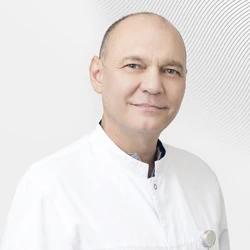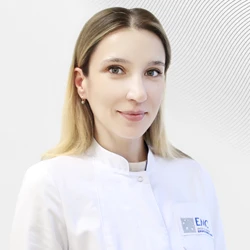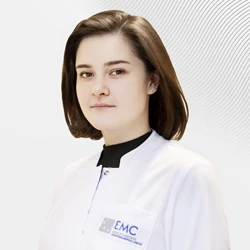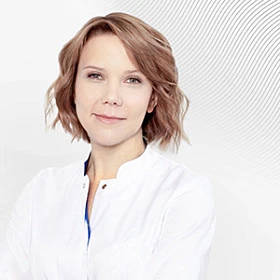Eczema - symptoms and treatment options at EMC
-
Diagnosis and treatment of eczema according to international protocols
-
Dermatologists with work experience and long-term internships in leading clinics in Israel and Western Europe
-
The opportunity to get a second opinion from the world's leading experts in the treatment of eczema
-
We help even in the most difficult cases
Eczema Treatment
In each case, a preliminary diagnosis is necessary for the correct selection of therapy, which may include immunological, allergological, biochemical methods and microbiological examination. If necessary, consultations are conducted with specialized specialists (therapist, endocrinologist, gastroenterologist, psychotherapist, etc.).
Comprehensive personalized treatment is prescribed taking into account the characteristics and degree of skin damage and always includes taking antihistamines.
When prescribing therapy, the doctor also takes into account the patient's gender and age, medical history, results of previous treatment, and individual drug intolerance. The key factors are the stage and prevalence of the disease.
What is eczema?
Eczema is a chronic inflammatory skin disease accompanied by itching, redness and rashes in the form of small bubbles with liquid. The rashes resemble air bubbles formed when water boils. Hence the name of the disease (from Greek eczeo - to boil).
Eczema is not transmitted from person to person. This is a genetically determined disease. Eczema is quite common, it is diagnosed in about 30-40% of patients who seek an appointment with a dermatologist .
What does eczema look like, and on which parts of the body does it appear
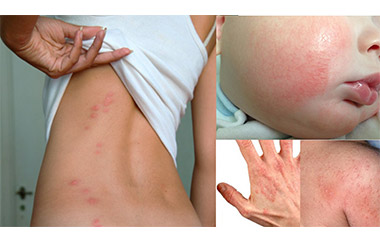
Wet and itchy skin on face and hands
Skin rashes in the form of blisters and bumps, accompanied by redness, may be manifestations of true eczema. Subsequently, the bubbles open with the release of serous fluid, shallow point erosions (ulcers) form in their place. The released liquid dries up to form a soft crust.
The appearance of repeated rashes in the area of the pathological focus leads to simultaneous localization of vesicles, ulcers, and crusts on the skin. All rashes are accompanied by severe itching, which causes significant discomfort to the patient and reduces the quality of life. Sometimes nighttime itching causes insomnia.
Rashes are characterized by symmetry and lack of clear boundaries in the affected area.
Rashes tend to spread to the chest, torso, abdomen, and back.
Scaly layer on the border of the scalp
Seborrheic eczema often develops on the scalp. In the initial stages, it is manifested by single yellowish nodules, the number of which increases rapidly. The nodules turn into spots with the formation of whitish scales on the surface.As a result of the fusion of the foci of rashes on the border of the hair, a “seborrheic crown” is often formed — a scaly ring, along the edges of which are areas of hyperemic skin. Without treatment, this form of eczema spreads from the scalp to the folds of the ear and neck.
Some doctors consider seborrheic eczema to be only a type of true seborrhea with minor differences during the pathological process.
Rounded rashes on the skin of the hands
Itchy rashes on the hands can indicate many different diseases. Eczema is one of them, in 80% of cases, true eczema is localized on the hands.Rashes at the initial stage have rounded outlines, with the development of the disease, the contours lose their correctness. A similar pattern of rashes on the hands is also characteristic of mycotic eczema.
Microbial eczema on the hands appears rarely and is characterized by the formation of purulent crusts on the surface.
Clear-edged rashes on the legs
Due to the increased frequency of skin injury and chronic venous insufficiency, post-traumatic and microbial eczema most often appear on the legs. In 75% of cases, they occur in women. Rashes are more often located next to varicose veins, have a rounded shape and clear boundaries. Microbial eczema is often manifested by a multitude of separate rounded foci up to 3 cm in size. Due to its similarity to a scattering of coins, this form of eczema is called coin-shaped.
Symmetrical scaly rashes on the body
The symmetry of the rashes is characteristic of true eczema. In most cases, it primarily appears on the extremities, but sometimes foci initially form on the trunk.In the early stages, the foci look typical and consist of bubbles filled with liquid. With prolonged course, areas of compacted skin with an increased skin pattern appear in place of the wet foci. In chronic eczema, the lesions become covered with flaky skin during healing, and the eczema becomes dry.
Fine-grained rashes on palms and soles
Eczema can affect the skin of the palms and feet. In these cases, due to the peculiarities of the skin structure, eczema foci appear as small whitish bumps. The bumps combine to form blisters that can open. After opening, large sores remain on the palms and feet, secreting serous fluid.
Callous rashes on palms
Rashes on the palms in the form of calluses that appear in uncharacteristic places for calluses may indicate tylotic eczema. Bubbles form, but may not open due to the peculiarities of the skin structure.
Thylotic eczema usually accompanies true eczema, so when callous rashes appear, it is recommended to pay attention to the rest of the body.
Multiple blisters in the axillary area with a hair in the center
Rashes with a hair in the center are a sign of sycosis, a special lesion of the hair follicles. Rashes of this kind, located outside the scalp, are called sycosiform eczema. Eczema is also indicated by the presence of itching, which is accompanied by rashes. In addition to the armpit area, this type of eczema can be localized on the chin, upper lip and pubic area.
Seals on the skin of the hands and on the body
Thickening of the skin may be evidence of the transition of eczema to a chronic form. Additionally, the chronization of the disease is indicated by a decrease in wetting and the appearance of large areas of compacted, flaky skin.
Depigmentation areas after peeling on the skin
They usually appear at the stage of recovery. At the site of the rash, the skin is lighter. Most often, such light spots go away on their own within a month.Depigmentation patches appear after most types of eczema, but more often after true and microbial eczema.
Multiple bumps on the face and hands without wetness and crusts
Sometimes, with true eczema, the blisters do not open, but appear only as multiple bumps and papules. This is how pruriginous eczema manifests itself – one of the varieties of true eczema. Pruriginous eczema is localized on the extensor surfaces of the hands and on the face.
Itchy areas of redness on the skin of the legs and arms
A hyperemic and itchy area of the skin with multiple rashes indicates true or microbial eczema. Itching of the skin in eczema is most pronounced at the stages of active formation of fresh papules and vesicles. The itching increases with the addition of bacterial flora.In varicose veins and post-traumatic eczema, these symptoms occur in most cases on the legs. In occupational eczema, itching and flushing are typical symptoms. The severity of the symptoms increases after repeated contact with the provoking agent. After eliminating the provoking factor, the symptoms disappear.
Suppuration and itching around wounds on legs and arms
Hyperemia of the skin and the formation of purulent crusts indicate microbial eczema. They most often appear on areas of the skin that are most susceptible to injury.When the pus dries, coarse crusts form, which fall off, exposing the skin that continues to get wet.
Types of eczema
Understanding the types of eczema is essential for proper treatment.
True or idiopathic eczema.
It has a classic course, rashes go through all six stages.
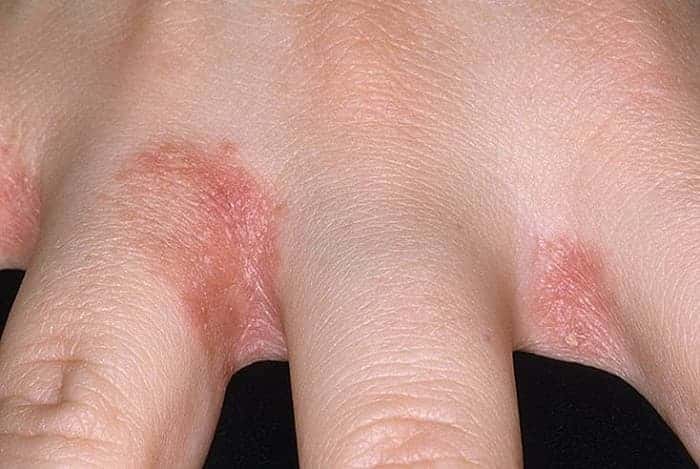
Stages of True Eczema:
The first stage. It is characterized by wide foci of hyperemia with a red-blue tint and with blurred edges without clear boundaries.
The second stage is papular formation. Soft nodular junctions appear, merging into small foci. Puffiness and plaques appear in places.
The third stage is vasocular. The nodules gradually turn into bubbles.
The fourth stage. The accumulation of subcutaneous exudate causes the opening of papules and the release of serous fluid. Pinpoint foci of maceration with depressions (wells) appear on the skin. At this stage, the development of the disease reaches its peak.
The fifth stage is steep. The released serous fluid begins to dry out, the forming crusts are layered on top of each other.
The sixth stage is squamous. Dried whitish scales separate on their own, the skin is restored. Pink or whitish spots may remain in the rash areas.
It is the serous wells that are the main distinguishing feature of true eczema. The foci of inflammation are more often arranged in a symmetrical order. The first symptoms appear on the face and hands, then the disease spreads to other parts of the body. Severe itching and soreness in the places of ulceration are added.
Without treatment, the process quickly develops into a chronic stage, when even during remission, the lesions become excessively thickened, and a pronounced linear pattern appears on the skin.
Chronic eczema
The acute stage of true eczema can quickly turn into a chronic one. It is characterized by densification and coarsening of endogenous foci. New rashes are actively appearing, followed by infiltration and the formation of serous wells. The itching increases many times and does not stop even at night, so patients with chronic eczema often suffer from insomnia. After getting rid of the symptoms, pigmentation is disturbed in the affected areas, and dry skin appears.
Exacerbations are more common in winter.
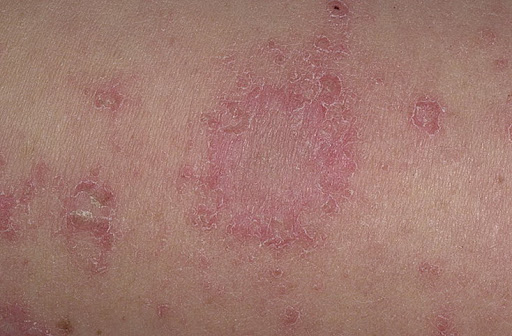
Microbial eczema
It is caused by infectious or fungal agents. It occurs at the stage of opening papules with true eczema or with chronic ulcerative-vegetative pyoderma, in places of fistulas, wounds, etc.
Pathogenic foci have clear pink borders. In addition to papules and weeping erosions, from which fluid is released, purulent crusts are deposited. The size of the affected areas increases rapidly. Often, separate pustules with scaly areas form near the foci.
Depending on the source of the disease, microbial eczema is divided into coin-shaped and varicose.
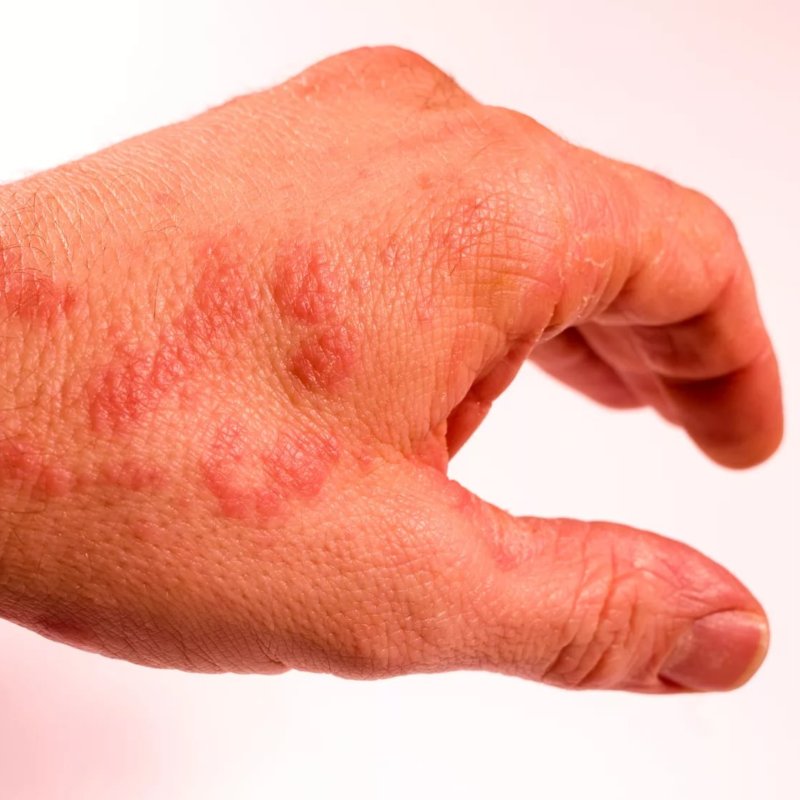
Coin-shaped eczema
The name is due to the appearance of red spots shaped like coins. Education may not take place for a long time (from a month to several years). In most cases, the symptoms begin to appear on the inner surface of the thigh and the outside of the hands.
In addition to the bubbles of red-pink, sometimes bluish tint, there is severe itching and burning, there is wetting after opening the rash.
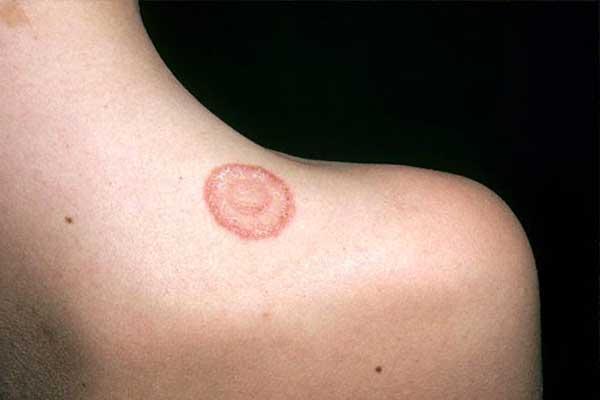
Varicose eczema
It develops primarily on the legs. It is accompanied by moderate itching, increased dryness of the skin, scaly formations in places of localization of dilated venous vessels. The disease strongly affects the condition of the skin - edematous, hyperemic foci with a maroon-purple hue appear. Specific dark spots appear on the skin.
Also, small bubbles form on the skin, which open with the release of fluid and the formation of ulcers. The wet stage turns into the drying stage after about two weeks. Crusty growths are formed. Pathological foci thicken and darken, up to a brown color. When pressed, soreness appears.
The inflammatory process is accompanied by severe itching. The patient combs the foci of inflammation, resulting in abrasions and cracks on the skin, and there is a risk of secondary infection.
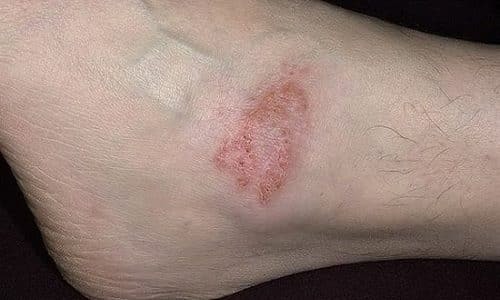
Seborrheic eczema
The trigger of this type of eczema is a weakening of local immunity, dysfunction of the sebaceous glands, and a violation of the nutrition of the scalp. Most patients have a history of congenital allergic reactions.
Each person has the fungus Pityrosporum ovale in the composition of the hair epithelial layer. In case of failures in the protective function, it can penetrate deeper, in response, the local immune system reacts in the form of an allergic reaction. The inflammatory process begins in the form of local edema. Normally, it stops after treatment of the fungus, but with seborrheic eczema, the inflammatory process is more pronounced and lasts for a long time.
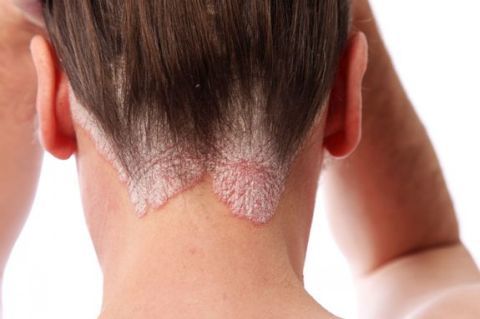
The peculiarity of seborrheic eczema is the excessive activity of the sebaceous glands in the lesions. Thinned skin scales are glued together and yellow fatty flakes are formed.
Localization of rashes:
-
trunk: navel area, chest, around the halo of mammary glands, in the folds of the axillary and inguinal zones;
- Head: nasolabial fold, ears and the area behind the ears, eyebrows, chin, eyelashes, scalp.
Dry eczema
At the initial stages, spots with blurred pink edges form, and subsequently the contours turn red. Sharp papules appear, merging into large plaques.
Bubbles do not form, but there is a violation of the integrity of the skin. The top thin and dry layer peels off, forming small and deep cracks. Without treatment, the disease progresses and becomes acute with weeping, the formation of dense crusts and severe redness. In this case, the patient may not experience painful sensations.
The disease worsens during the dry and cold seasons of the year.
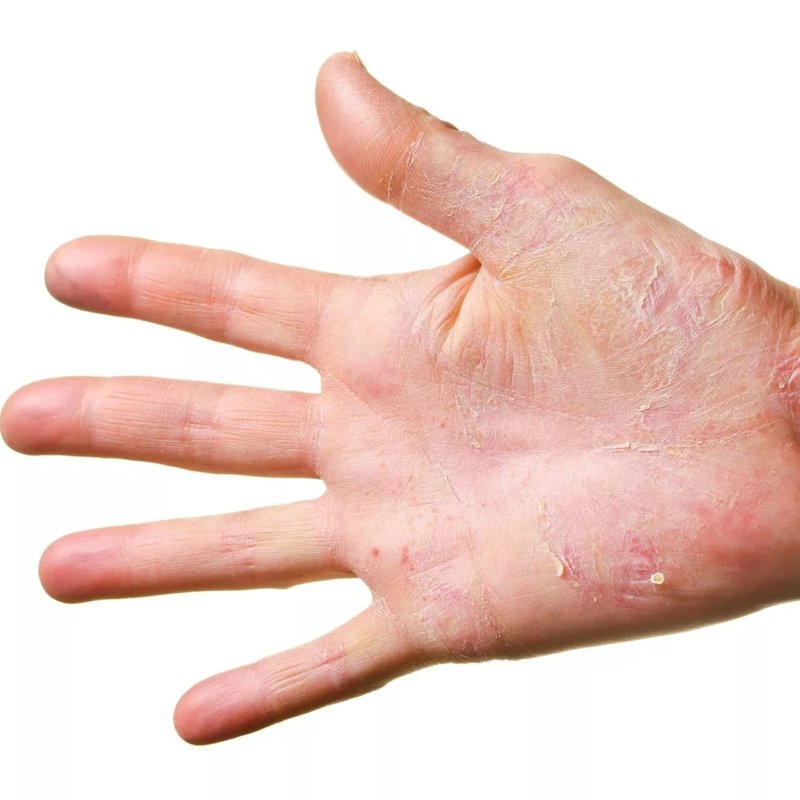
Allergic eczema
It is a consequence of the body's hypersensitivity to external or internal stimuli. It develops more often in patients with a weak immune response.
The main factor is contact with foreign compounds that cause excessive histamine production.
Any manifestations of the disease cause agitation of the nervous system, so the patient experiences irritation, may suffer from insomnia and severe headaches.
Symptoms:
-
rashes accompanied by itching,
-
dryness and peeling of the skin,
-
crusts form in place of the bursting bubbles,
-
redness of the skin, burning sensation,
-
thickening of the skin in the lesion.

The second type is more often localized on the hands and occurs due to direct contact with a chemical substance. At the same time, the skin swells strongly, red foci with small papules appear, which after opening turn into painful ulcers.
Rashes with this type of eczema can appear on any part of the body.
Dyshidrotic eczema
Dyshidrosis affects the sweat glands of the feet (in 20% of cases) and hands (80%), and has a chronic course with seasonal exacerbations. Serous vesicles form on the affected areas.A distinctive feature of dyshidrosis is the development of vesicles. The rashes are covered with a dense shell. Purulent discharge appears only when a secondary infection is present. Under normal conditions, the formations contain a clear liquid.
All stages are accompanied by gradually increasing itching. The lesions swell and peel off. The vesicles open themselves, either during combing or damage, and small wounds and cracks appear in their place. The skin pattern becomes more distinct.
With this type of eczema, itching appears earlier than skin symptoms, rashes form later, first on the sides of the fingers, then on the palms and feet.

Weeping eczema
This species is characterized by several phases. The first phase: pink spots of various shapes and sizes appear on the skin, swelling, as well as papules or vesicles. Due to the constant release of subcutaneous exudate, wet zones are formed.Upon opening, the formations are covered with crusts with active exfoliation. The peculiarity of this type is that the rash is at different stages of development. New and already opened rashes may be located in one zone, and rejection of dead cells is also observed. Severe itching causes insomnia and neurosis.
When the process is chronic, the skin in the affected areas thickens and scars, and a blue-red tint appears. During remission, the skin in the lesions is constantly peeling off.
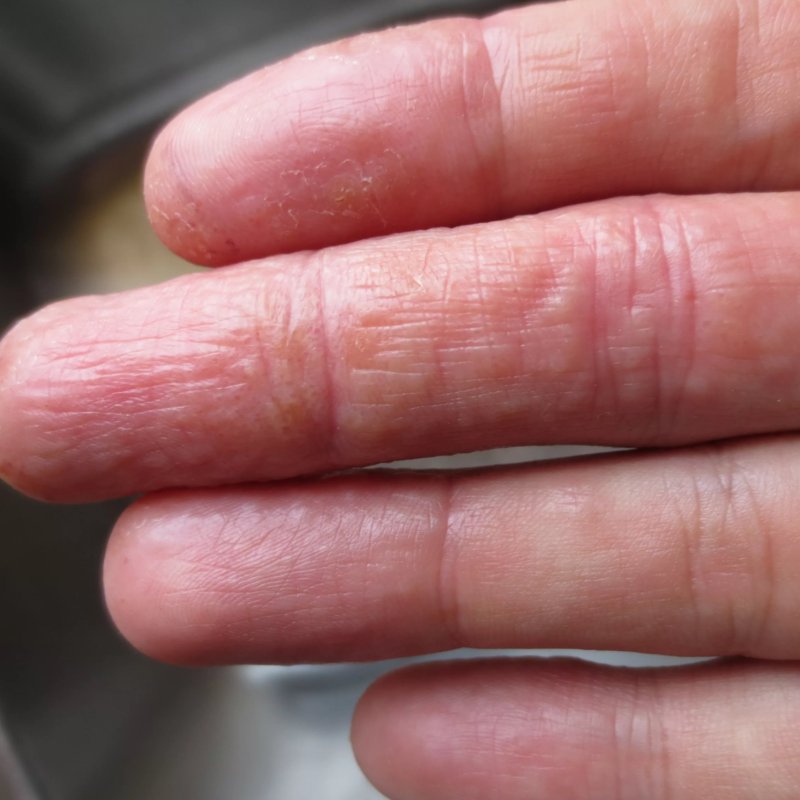
Symptoms
The symptoms of eczema may vary depending on the type of disease, but there are common symptoms.:-
regular increase in body temperature during occupational eczema;
-
the appearance of a focus of inflammation and redness, thickening of the skin;
-
the appearance of a rash;
-
increased skin sensitivity, itching, which reduces the patient's quality of life;
-
the appearance of painful cracks, wounds, erosion at the site of rashes, the formation of serous or hemorrhagic crusts;
- increased dryness of the skin, loss of elasticity during remission.
Eczema is difficult to treat, and frequent relapses are possible, but thanks to modern protocols, doctors are increasingly able to achieve lasting remissions. It is important to consult a doctor in a timely manner.
Eczema on the face
Urban air, climate features, and improper care can have a negative effect on the skin. If you notice itchy, edematous reddish spots on your face with rashes in the form of bubbles that burst, forming crusts, and the crusts then merge into a large wet spot, make an appointment with a dermatologist immediately. This is especially true considering that eczema is accompanied by severe burning and itching.
The disease is characterized by symmetry, if rashes appear on one side of the face, they will appear on the other. Eczema can affect the mouth and eye area. The skin on the eyelids thickens and coarsens, itching and peeling appear. Lamellar scales form on the lips, which then turn into bleeding, painful cracks.
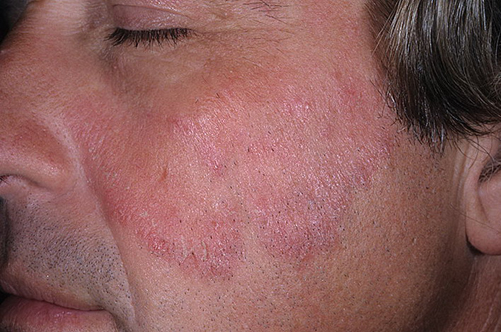
Eczema on the legs
Eczema on the legs often appears as a result of an allergic reaction and the presence of vascular pathology of the lower extremities (varicose eczema). Psychoemotional state and decreased immunity can also be triggers.Microbial eczema appears most often on the legs. It is localized in places of burns, postoperative sutures, fungal infection, varicose veins. Eczema occurs against the background of an existing inflammatory process.
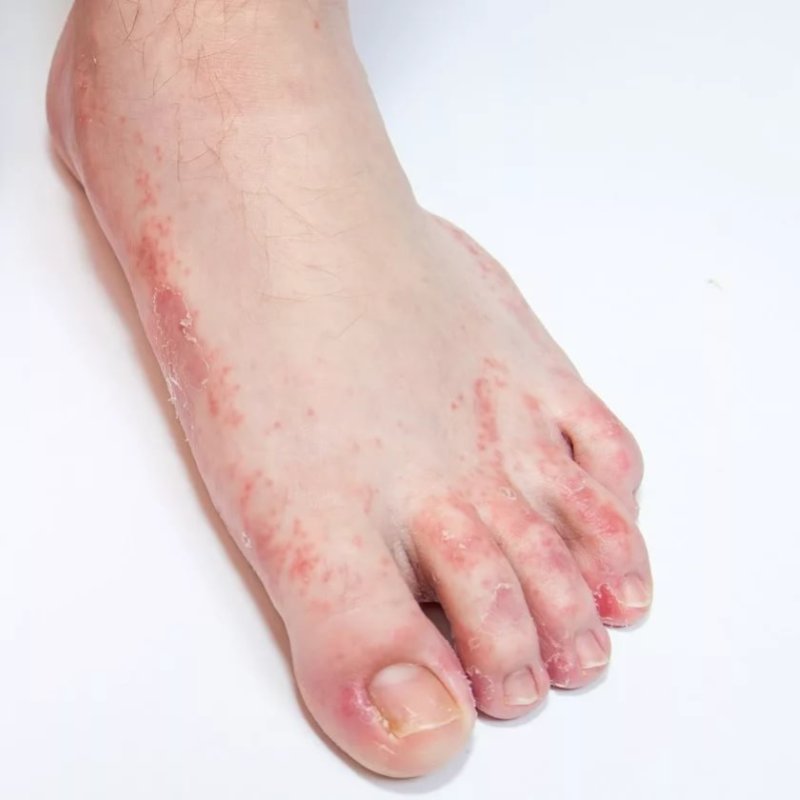
The main symptoms of eczema on the legs:
-
swelling of the legs;
-
the appearance of a characteristic crust;
-
painful appearance and dry skin;
- the appearance of bubbles, cracks and pigmentation in the localization sites.
Possible sleep disorders and headache.
Self-treatment of eczema is unacceptable. It can lead to complications and complicate the treatment process.
Eczema on the hands
According to the intensity of the disease on the hands, acute and chronic eczema can be distinguished.
Depending on the triggers, the following are highlighted:
-
microbial (affects areas around wounds, abrasions, boils),
-
professional,
- dyshidrotic (affects palms, nails), horny (may manifest in the form of calluses).
There is childhood eczema, which is manifested by a severe rash on the hands and can go away with age.
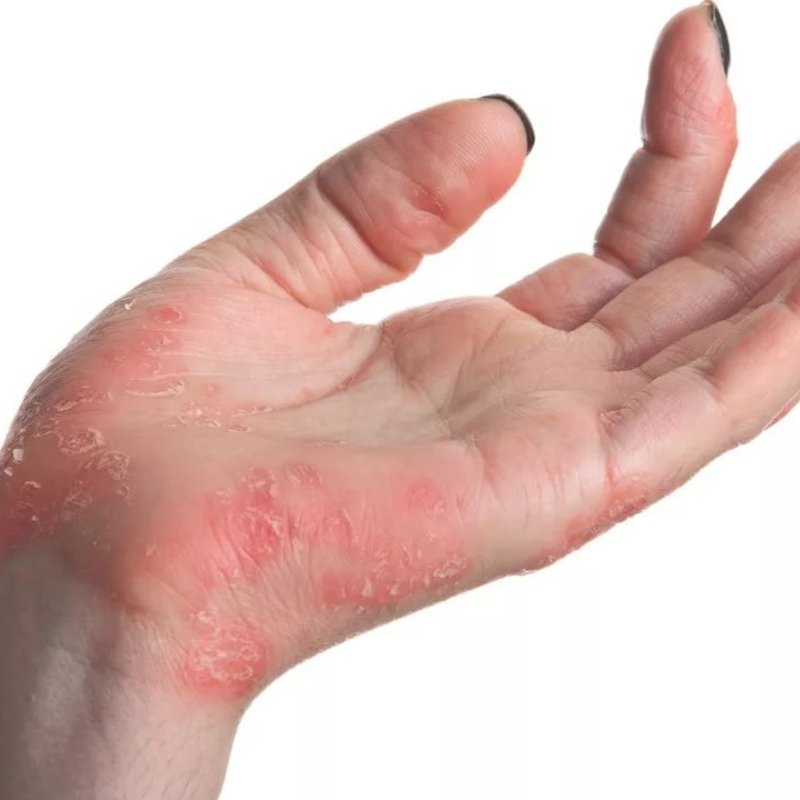
There are 4 stages of the disease:
- Erythematous – edema and redness of the focus.
-
Papulovesicular – the appearance of rashes.
-
Wet – opening of bubbles.
-
Cortical – the formation of crusts.
When the disease passes into the chronic stage, the skin becomes rough, pigmentation, peeling, and dryness appear.
Causes of the disease
Hereditary factor is the main cause of eczema. If there are cases of eczema in close relatives, the patient is significantly more likely to develop this disease.
One of the provoking factors is immune disorders. The immune system begins to produce immunoglobulins to its own skin cells, which leads to the appearance of areas of inflammation. Violation of intercellular immunity is confirmed by an imbalance of glycoproteins: laboratory values of IgG and IgE are higher than normal, IgM is in deficit.
There is a link between eczema exacerbations and stress.
It has been scientifically proven that eating habits and disorders in the digestive tract can also affect the development of eczema.
How to treat eczema

Weeping eczema
Weeping eczema is common to all types of eczema. After the diagnosis, the dermatologist will draw up a personalized treatment plan, including:
- Medical treatment:
a) general;
b) local.
-
Physical therapy.
-
Dieting.
Dry eczema
Dry eczema is manifested by excessive dryness of the skin. The distinctive features are:
-
chronic course;
-
seasonal exacerbations;
- localization on any part of the skin, but most often on the extremities.
During treatment, adherence to therapy is extremely important, and all measures prescribed as part of the treatment plan must be fully implemented. Treatment should not be interrupted at the first sign of improvement.
Corticosteroids in the form of ointment show a good effect in the early stages of eczema development. But they are not recommended for long-term use. To eliminate the symptoms, emollients are used in the future.
The attending dermatologist may recommend consultations with specialized specialists: an endocrinologist, a gastroenterologist, etc. A multidisciplinary approach makes it possible to improve the results of therapy.
Treatment of eczema with medications
The development of eczema is associated with increased sensitivity of the body to a number of stimuli. Therefore, treatment should be systemic with the appointment of hormonal ointments, antihistamines, and antibiotics. The doctor's task is to select the most effective drugs in each specific case.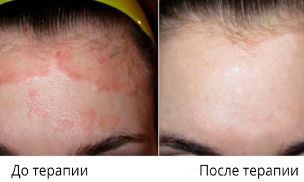
Sorbents and antihistamines
Antihistamines help to get rid of itching and inflammation.Antibacterial therapy
Antibiotics with tetracycline are prescribed with caution to children under 10 years of age. Laboratory diagnostics helps the doctor determine the safest drug.Medications that relieve itching and sedatives
-
moisturizers;
-
oral substances;
-
Intravenous corticosteroids.
Among sedatives, Novopassit, Persen, and Valemidine are more often prescribed.
Hormonal drugs
Therapeutic regimens include hydrocortisone. Hormonal drugs are recommended in the form of ointments, tablets, lotions. These drugs are not recommended for use for more than 2 weeks due to possible complications.Corticosteroid-based creams are effective for weeping eczema because they dry out the skin. Ointments have a healing effect and eliminate rough crusts. When localized in the scalp, emulsions and lotions with a light texture are used.
Antiseptic and anti-inflammatory agents
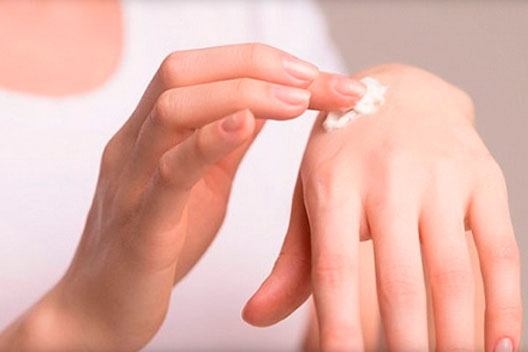
-
"Betadine";
-
"Miramistin";
-
"Dekasan";
-
"Dimexide";
-
Clotrimazole and Polyphepan;
-
"Radevit";
-
"Chlorhexidine".
The choice of the drug depends on the type of eczema and on concomitant diseases, therefore it should be carried out only by the attending physician.
Features of eczema treatment on hands
Ointments (pastes and creams) with corticosteroids, hormones with a pronounced anti–inflammatory effect, are used for the local treatment of eczema. They can reduce the inflammatory response and accelerate the process of skin regeneration.Ointments with corticosteroids have side effects: thinning of the skin, increased risk of bacterial and fungal infections, etc. Therefore, they should be prescribed only by the attending physician.
There are non-hormonal drugs that are also effective in treating eczema. These are topical calcineurin inhibitors, tacrolimus ointment (protopic) and pimecrolimus cream. They reduce inflammation and itching. The dosage and duration of administration should also be determined only by the attending physician.
With severe eczema, extensive foci of inflammation, and no effect from local therapy, systemic treatment is prescribed in the form of immunosuppressants, drugs that suppress the immune system.
In severe cases of the disease, as well as in cases of erythroderma, cytostatics are prescribed.
Antibiotics and antifungal agents are used in the treatment of microbial and fungal eczema.
Features of eczema treatment on legs
Eczema on the legs often develops due to an allergic reaction or severe vascular pathology (varicose eczema). Additional provoking factors may be weakened immunity and prolonged psycho-emotional stress.
Microbial eczema develops most often on the legs. The main localization is in places of burns, postoperative sutures, fungal infection, varicose veins. Eczema develops against the background of an existing inflammatory process.The main symptoms of eczema on the legs:
-
edema;
-
formation of a characteristic crust on the skin;
- the appearance of blisters, cracks and pigmentation in the lesions.
Sleep disorders and headaches may occur.
With timely medical attention, the prognosis for the treatment of eczema on the legs is favorable.
What does eczema treatment consist of
The essence of eczema treatment is:
-
avoiding contact with irritants,
-
proper nutrition,
-
elimination of itching,
-
local treatment with ointments and creams,
-
general treatment with tablet drugs and injections.
Treatment of eczema in children
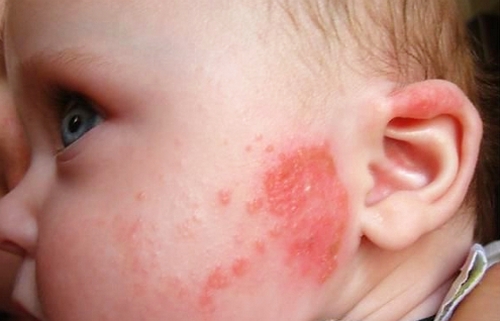
To determine treatment tactics, it is necessary to identify the type of eczema, the cause of its appearance, and differentiate it from other dermatological diseases (herpes simplex, diathesis, allergic reactions, urticaria, lichen, etc.).
Diagnosis includes:-
general blood test;
-
skin scraping for microscopic examination;
-
allergy tests for atopic eczema to identify the source of the allergy;
- Histological examination is used to diagnose autoimmune diseases.
The treatment is selected taking into account the results of examinations, age and health characteristics of the small patient.
Comprehensive therapeutic treatment includes:
-
Individual diet
-
Sedatives (for sleep regulation)
- Antihistamines (to relieve itching and burning)
-
Anti-inflammatory drugs (to relieve skin puffiness and improve general condition)
-
Multivitamins
-
Antibiotics or antiviral drugs
To speed up the recovery process, as well as as an alternative to some medications, physiotherapy can be prescribed.
Antiseptic treatment of wounds and abrasions is mandatory to exclude secondary infections.
It is especially important to properly care for the baby's skin and follow all the recommendations of a dermatologist who will select individual care products.
Eczema prevention
Personal hygiene is important, frequent overheating, accompanied by increased sweating, is unacceptable. A balanced diet should include dairy and vegetable foods with low amounts of carbohydrates and spices.
Prevention of eczema in adults
Overwork and stress can be triggers for the development of eczema, so it is important to maintain a balance between work and personal life, devote time to proper sleep and rest, and exercise.
Use gloves when working around the house, this will eliminate the possibility of aggressive detergents getting on the skin. Thoroughly clean your hands and use protective moisturizers.
With increased oily skin and a genetic predisposition to eczema:
- It is recommended to exclude fatty, sweet, fried and spicy dishes from the diet.
-
it is not recommended to visit the sauna and steam room.
- It is not advisable to visit countries with high humidity or too hot climate.
In case of professional eczema, it is recommended to change your place of work to avoid complications.
Prevention of eczema in children
-
Compliance with personal hygiene rules
-
Absence of diaper rash
-
Healthy and balanced diet
-
Regular cleaning
-
Shoes and clothes made of natural materials
-
Seaside vacations
If symptoms occur, do not delay the visit to the doctor.
Make an appointment for a consultation with for dermatologists of the EMC, please call +7 (495) 933 66 55.
Why the EMC
The first and only clinic in Russia, created in the image of the world's leading clinics
EMC is a multidisciplinary center offering patients a high level of medical services and a personalized approach
Worldwide recognition and awards
 Learn more
Learn more
Worldwide recognition and awards
 Certificates and licenses
Certificates and licenses
Make an appointment for a consultation
Specify your contacts and we will contact you to clarify the details
Reviews
and new products of the EMC
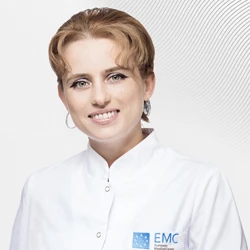
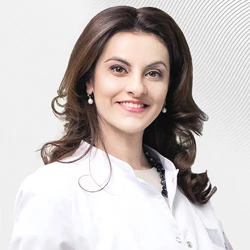
.webp)
.webp)
.webp)
